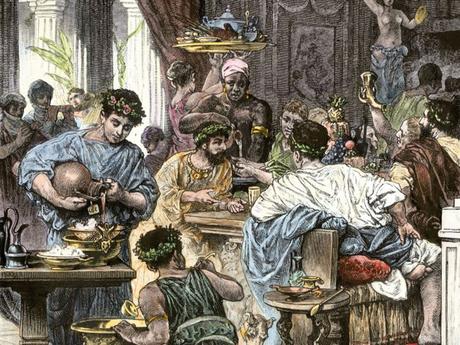
Life for the residents of Pompeii was lively before the doomed eruption of Mount Vesuvius in 79 AD which destroyed the city. Pompeii was once a mega Roman hub fit with its own amphitheatre, baths and tavern; many of which can be viewed today at the ancient site. Most of the activity of the residences happened during the day, as when night fell the city became a dark and dangerous place. From excavations at the site today, we can piece together what a day in the life of a Pompeiian was like.
Food in Ancient Pompeii
Cooking completed by the Pompeiians was usually conducted over an open hearth where they usually smoked, fried or baked their local meats and fish. The diets of the common people were quite simple, and their meals were almost always accompanied by bread and seasonal fruit from the region. Local specialties of the region such as anchovies and olives were known to be a favorite of the people, including vegetables such as cabbage, asparagus and carrots. There were also chances for the middle class to eat at taverns or inns for a more complex meal. These dishes often included chicken seasoned in a fragrant wine sauce or a traditionally Pompeii style fish. The difference between the diets of the wealthy however were outstanding, as evidence has shown that they would often indulge in seven course meals and luxuries such as sea urchin.
Clothing
Men were known to wear the traditional tunic which was then covered by a cloak. Men with noble ties dressed in longer robes called togas, much like those of the Ancient Grecians. Fashion and beauty were extremely important to the women of Ancient Pompeii, with a pale face, red lips and darkly rimmed eyes being viewed as the epitome of beauty in this era. The women wore stolas, which were long dresses held together by pinned brooches. Blonde hair was also highly sought after so the rich usually wore wigs made from the hair of Celtic enslaved women. Other methods included weaving golden threads through complex braids which were common at the time.
Activities
Life for Pompeiians began when the sun rose in a bustling marketplace where merchants would tempt local citizens to visit their stalls. A large amphitheater was constructed nearby, where Pompeiians and citizens from close towns would come to witness spectacular gladiator battles and theatrical plays. After lunch, the afternoon was spent at thermal baths. This was the place to be seen in ancient times and many residents came to socialise, gossip and indulge in the many different types of baths that the location offered.
Houses
The area of Pompeii today has been sectioned off into quarters based on the type of houses the residents lived in. A typical housing structure was rectangular in shape and windowless, as the house would be focused around an internal courtyard. The wealthiness of the homeowner would determine the amount of rooms that the house had, and colourful frescoes and mosaics adorned the entrance way, walls and floors of the villa. Those who were poorer usually lived in buildings with shops on the first storey and smaller spaces on the second floor. Documents discovered by scholars Larger houses were found to have sections that were available for rent. As Pompeii was at its best a resort style getaway for the elite, the wealthy were known to supply the poorer people with copious amount of alcohol and gladiator battles to distract the commoners from their economic problems.
Advertisements
